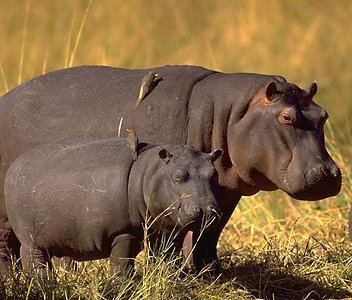Phylum Chordata Order Artiodactyla Scientific name Hippopotamidae Gestation period Hippopotamus: 243 days | ||
 | ||
Family HippopotamidaeGray, 1821 Mass Hippopotamus: 1,500 – 1,800 kg Lifespan Hippopotamus: 40 – 50 years Similar Hippopotamus, Mammal, Pygmy hippopotamus, Even‑toed ungulate, Human | ||
Flusspferde im zoo hannover hippopotamidae hippopotamus amphibius
Hippopotamuses are stout, naked-skinned, and amphibious artiodactyl members (and the only living members) of the family Hippopotamidae possessing three-chambered stomachs and walking on four toes on each foot. While they resemble pigs physiologically and are pseudoruminants like camels, their closest living relatives are actually the cetaceans (whales and dolphins).
Contents
- Flusspferde im zoo hannover hippopotamidae hippopotamus amphibius
- Characteristics
- Evolution
- Analogous structures
- Species
- References

There are two living species of hippopotamus in two genera; the pygmy hippo, Choeropsis liberiensis of the forests of west Africa, and the common hippo, Hippopotamus amphibius.

Characteristics
Hippopotamuses are large mammals, with short, stumpy legs, and barrel-shaped bodies. They have large heads, with broad mouths, and nostrils placed at the top of their snouts. Like pigs, they have four toes, but unlike pigs, all of the toes are used in walking. Hippopotamids are unguligrade, although, unlike most other such animals, they have no hooves, instead using a pad of tough connective tissue on each foot. Their stomachs have three chambers, but they are not true ruminants.
The living species are smooth-skinned and lack both sebaceous glands and sweat glands. The outer epidermis is relatively thin, so hippos dehydrate rapidly in dry environments.
Both the incisors and canines are large and tusk-like, although the canine tusks are by far the larger. The tusks grow throughout life. The postcanine teeth are large and complex, suited for chewing the plant matter that comprises their diets. The number of incisors varies even within the same species, but the general dental formula is:
Evolution
The hippopotamids are descended from the anthracotheres, a family of semiaquatic and terrestrial artiodactyls that appeared in the late Eocene, and are thought to have resembled small- or narrow-headed hippos. More specifically, the hippos split off from the anthracotheres some time during the Miocene. After the appearance of the true hippopotamids, the anthracotheres went into a decline brought about by a combination of climatic change and competition with their descendants, until the last genus, Merycopotamus, died out in the early Pliocene of India.
There were once many species of hippopotamid, but only two survive today: Hippopotamus amphibius, and Choeropsis liberiensis. They are the last survivors of two major evolutionary lineages, the hippos proper and the pygmy hippos, respectively; these lineages could arguably be considered subfamilies, but their relationship to each other - apart from being fairly distant relatives - is not well resolved.
The enigmatic Miocene Kenyapotamus is insufficiently known to be assigned a place in the hippo phylogeny with any degree of certainty. In addition, the genus Hexaprotodon, in a sense now restricted to an extinct group of animals once living around the northern and northeastern Indian Ocean, which formerly included most ancient hippos, has turned out to be paraphyletic.
Analogous structures
The lower canine teeth of hippopotamids are similar in function and structure to the tusks of elephants. While hippopotamids and elephants are only very distantly related within the Mammalia, the lower canine teeth of both groups are long and have a slight curve, and species of both families use this structure when fighting.
Species
The systematics and taxonomy used here mostly follows the review of Boisserie (2005).
